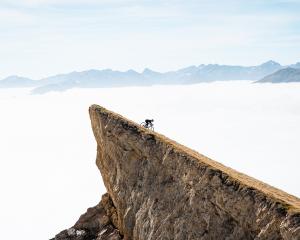
Otago Regional Council-led investigations into potential hazards for the Dart and Rees River floodplain and the Glenorchy township show a major earthquake, or flood, could have a severe effect on the area.
Hydraulic modelling and a flood hazard investigation commissioned by the council show swathes of the township could be under water during once-in-a-century floods.
Particularly at risk was the northern end of town closest to the Rees River, the Land River Sea Consulting investigation found.
The Glenorchy floodbank was undersized and anything greater than a one-in-20-year flood would overwhelm the protection it provided, the investigation report said.
Meanwhile, in a separate study, Tonkin & Taylor engineer Nathan McDougall said overall liquefaction posed a significant risk to Glenorchy.
There would likely be severe and widespread liquefaction damage in a medium to large earthquake, Mr McDougall’s report said.
"The hazard posed by the Alpine Fault is extremely high over the next 50 years and so the likelihood of a severe level of liquefaction damage, including severe damage from lateral spreading in the western side of Glenorchy, occurring in the next 50 years is very high," Mr McDougall said.
The consultants’ reports have been summarised and will be presented by council natural hazards manager Jean-Luc Payan and natural hazards analyst Tim van Woerden in a report to the council’s data and information committee next week.
The investigations represented a major advance in the understanding of the natural hazards in the area, their report said.
It was expected to help in adaptation planning and decision-making, as well as emergency services responses and community readiness in case of a disaster, they said.
Furthermore, if a flood and earthquake were to overlap, the effects would be compounded, they said.
"The flooding and liquefaction hazard risks considered individually each pose a concerning hazard threat," they said.
"However, there is also considerable overlap in the likely spatial extents of these hazard impacts, and potential for cascading hazard interactions between these hazards.
"The cumulative multi-hazard risks will therefore be higher than the individual hazard risk."
The report to the committee said any decision-making on managing these risks should involve community input and collaboration.
It also said the "acceptability" of the natural hazard risks would depend on the community’s view of the risk and its tolerance for it.
The community as a whole might not have a single, collective view on whether the risks identified were acceptable, it said.
The investigations were prompted as a result of a consent application hearing for the Grand Mount Earnslaw Hotel.
When consent was granted for the 52-room Glenorchy facility, Mountain Scene reported commissioners rejected a council call for more investigative work to be done.
The staff report said investigations for the development near the Glenorchy waterfront identified the potential for significant liquefaction and lateral spreading to occur in that location, prompting the investigation by the council to understand the extent to which similar ground conditions or hazards impacts might happen elsewhere.
An assessment of potential approaches to managing the liquefaction or flooding risks would be developed with the community, Queenstown Lakes District Council and others, the report said.
Advertisement













